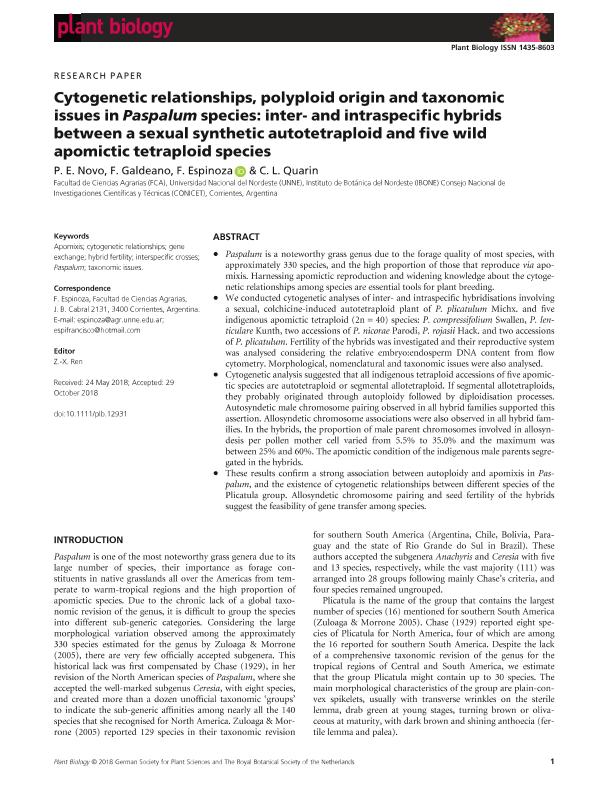Mostrar el registro sencillo del ítem
dc.contributor.author
Novo, Patricia Elda

dc.contributor.author
Galdeano, Florencia

dc.contributor.author
Espinoza, Francisco

dc.contributor.author
Quarin, Camilo Luis

dc.date.available
2020-06-25T15:15:25Z
dc.date.issued
2018-11
dc.identifier.citation
Novo, Patricia Elda; Galdeano, Florencia; Espinoza, Francisco; Quarin, Camilo Luis; Cytogenetic relationships, polyploid origin, and taxonomic issues in Paspalum species: inter- and intraspecific hybrids between a sexual synthetic autotetraploid and five wild apomictic tetraploid species; Wiley Blackwell Publishing, Inc; Plant Biology; 21; 2; 11-2018; 267-277
dc.identifier.issn
1435-8603
dc.identifier.uri
http://hdl.handle.net/11336/108221
dc.description.abstract
Paspalum is a noteworthy grass genus due to the forage quality of most species, the total number of approximately 330 species, and the high proportion of those that reproduce via apomixis. Harnessing apomictic reproduction and widening the knowledge about the cytogenetic relationships among species are elemental tools for plant breeding.We conducted cytogenetic analyses of inter‐ and intraspecific hybridizations involving a sexual, colchicine‐induced autotetraploid plant of P.plicatulum Michx. and five indigenous apomictic tetraploid (2n = 40) species: P. compressifolium Swallen, P. lenticulare Kunth, two accessions of P. nicorae Parodi, P. rojasii Hack., and two accessions of P. plicatulum. The fertility of the hybrids was investigated and their reproductive system was analyzed considering the relative embryo:endosperm DNA content by flow cytometry. Morphological, nomenclatural and taxonomic issues were also analyzed.Cytogenetic analysis suggested that all indigenous tetraploid accessions of five apomictic species are autotetraploid or segmental allotetraploid. If segmental allotetraploids, they probably originated by autoploidy followed by diploidization processes. Autosyndetic male‐chromosome pairing observed in all hybrid families supported this assertion. Allosyndetic chromosome associations were also observed in all hybrid families. In the hybrids, the proportion of male‐parent chromosomes involved in allosyndesis per pollen mother cell varied from 5.5 to 35% and the maximum ranged between 25‐60%. The apomictic condition of the indigenous male parents segregated in the hybrids.These results confirm a strong association between autoploidy and apomixis in Paspalum, and the existence of cytogenetic relationships between different species of the Plicatula group. Allosyndetic chromosome pairing and seed fertility of the hybrids suggest the feasibility of gene transfer among species.
dc.format
application/pdf
dc.language.iso
eng
dc.publisher
Wiley Blackwell Publishing, Inc

dc.rights
info:eu-repo/semantics/openAccess
dc.rights.uri
https://creativecommons.org/licenses/by-nc-sa/2.5/ar/
dc.subject
PASPALUM
dc.subject
GENE EXCHANGE
dc.subject
INTERSPECIFIC COSSES
dc.subject
HYBRID FERTILITY
dc.subject.classification
Ciencias de las Plantas, Botánica

dc.subject.classification
Ciencias Biológicas

dc.subject.classification
CIENCIAS NATURALES Y EXACTAS

dc.title
Cytogenetic relationships, polyploid origin, and taxonomic issues in Paspalum species: inter- and intraspecific hybrids between a sexual synthetic autotetraploid and five wild apomictic tetraploid species
dc.type
info:eu-repo/semantics/article
dc.type
info:ar-repo/semantics/artículo
dc.type
info:eu-repo/semantics/publishedVersion
dc.date.updated
2020-06-23T14:50:04Z
dc.journal.volume
21
dc.journal.number
2
dc.journal.pagination
267-277
dc.journal.pais
Reino Unido

dc.journal.ciudad
Londres
dc.description.fil
Fil: Novo, Patricia Elda. Consejo Nacional de Investigaciones Científicas y Técnicas. Centro Científico Tecnológico Conicet - Nordeste. Instituto de Botánica del Nordeste. Universidad Nacional del Nordeste. Facultad de Ciencias Agrarias. Instituto de Botánica del Nordeste; Argentina
dc.description.fil
Fil: Galdeano, Florencia. Consejo Nacional de Investigaciones Científicas y Técnicas. Centro Científico Tecnológico Conicet - Nordeste. Instituto de Botánica del Nordeste. Universidad Nacional del Nordeste. Facultad de Ciencias Agrarias. Instituto de Botánica del Nordeste; Argentina
dc.description.fil
Fil: Espinoza, Francisco. Consejo Nacional de Investigaciones Científicas y Técnicas. Centro Científico Tecnológico Conicet - Nordeste. Instituto de Botánica del Nordeste. Universidad Nacional del Nordeste. Facultad de Ciencias Agrarias. Instituto de Botánica del Nordeste; Argentina
dc.description.fil
Fil: Quarin, Camilo Luis. Consejo Nacional de Investigaciones Científicas y Técnicas. Centro Científico Tecnológico Conicet - Nordeste. Instituto de Botánica del Nordeste. Universidad Nacional del Nordeste. Facultad de Ciencias Agrarias. Instituto de Botánica del Nordeste; Argentina
dc.journal.title
Plant Biology

dc.relation.alternativeid
info:eu-repo/semantics/altIdentifier/doi/http://dx.doi.org/10.1111/plb.12931
dc.relation.alternativeid
info:eu-repo/semantics/altIdentifier/url/https://onlinelibrary.wiley.com/doi/abs/10.1111/plb.12931
Archivos asociados
